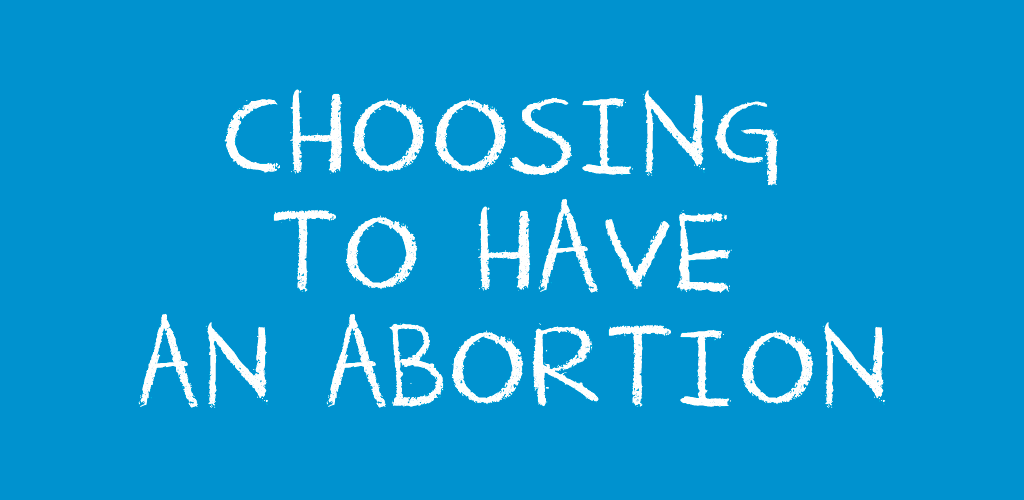Choosing to Have An Abortion
Deciding to have an abortion can be a major decision. Are you unsure? Take the time you need to make your decision.
When you are pregnant, we believe that you have the right to access factual, caring and non-judgmental information and services on all three of your options: abortion, adoption, and parenting.
There are many myths about abortion. Some people have strong opinions about abortion and may try to pressure you into a decision. To make your own choice, it is helpful to have all the facts.
What is an abortion?
- An abortion is a safe medical procedure that ends a pregnancy.
- Abortions are fully legal in Canada.
Types of abortion
There are 2 categories of abortion: surgical and medical.
The options you have depend on how long you’ve been pregnant (gestational age, or GA, calculated by the time since the first day of your last menstrual* period) and what’s offered at the clinic/hospital you go to.
Medical abortion (includes the abortion pill)
- A medical abortion uses medication to stop the growth of a pregnancy and then expel the pregnancy tissue from the uterus*.
- This type of abortion is done early in pregnancy. Clinics in Toronto typically offer it up to 8 to 9 weeks GA.
- To get a medical abortion, you make an appointment at a clinic that offers it. You may have a counselling session, ultrasound, STI test, and/or some blood tests. You take a pill to detach the pregnancy from the wall of the uterus OR get an injection to stop the pregnancy from growing. Later, you take tablets at home to make your uterus contract to expel the pregnancy tissue.
- Pregnancy tissue usually expels within 24hrs after you take the tablets at home, but in some cases may take days or weeks to finish. Different medications are more or less likely to finish the process quickly. You will get a blood test in a few days to make sure it finished. You may need follow up blood tests or visits until the tissue is expelled or if any concerns arise.
Surgical abortion
- To get a surgical abortion you have a 2-3 hour long intake appointment that includes a counselling/education session, ultrasound, and test for sexually transmitted infections (STIs). Depending on the clinic/hospital and gestational age (GA) you may be able to have the abortion procedure in the same appointment.
- Depending on the type of abortion you’re getting, you’ll be given general anaesthesia (where you’re put to sleep), local anaesthesia to numb the area, painkillers, or conscious sedation (where you’re groggy or calmed, but awake). Usually hospitals will use general anesthetic, while clinics may use a combination of local anaesthetic, pain killers, and conscious sedation.
- There is no cutting and no stitches are needed. The cervix is gently opened with medication and/or medical instruments. A flexible tube providing gentle suction and/or other instruments are inserted through the cervix and used to remove the pregnancy tissue from the uterus. This can take 2-15 minutes.
- For pregnancies more than 12 weeks GA, you may take medication or have laminaria (sterilized compressed seaweed sticks) inserted into your cervix to make opening your cervix for the abortion easier. These take time to work, so you may return to the clinic/ hospital the next day for the abortion procedure. For pregnancies of more than 19 weeks GA, you may return the next day for more medication/ laminaria to continue opening your cervix and return on a third day for the abortion procedure.
- After the abortion procedure you stay in a recovery area until the medical staff are confident you can go home safely.
- You cannot drive yourself home after an abortion.
- You are often allowed to have a support person with you at the clinic though they will likely not be allowed into the room where the procedure takes place. In most cases there will still be support staff there besides the doctor to ensure your procedure is as comfortable as possible.
Differences in medical abortions by medication:
| Methotrexate and Misoprostol | Mifepristone and Misoprostol (the abortion pill, Mifegymiso) | |
| how far along in pregnancy (gestational age) | up to 7 weeks | up to 9 weeks |
| how you take it |
|
|
| % finished w/in 24hrs of tablets | 65% | 90% |
| cost | Free with Ontario health card; about $300 without one | Free with Ontario health card; about $300-$350 without one |
| Useful Tip |
| In 35% of medical abortions, it takes several days or weeks to release all of the pregnancy tissue. This tissue may take one or more days to start coming out. There is no way to know when it will start, so you may have to leave work or school immediately if it suddenly starts. Also, medical abortions may involve more cramping and bleeding than a surgical procedure. |
For a downloadable resource on this topic, please visit Planned Parenthood Toronto Factsheet Database.
If you have questions about this topic, feel free to contact one of our peer educators. [Link]
*We know that these aren’t the words everyone uses for their bodies (eg. trans folks), and support you using the language that feels best for you.
Last Edited: May 2020






